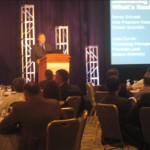Dec07
Shell, HP, Clorox & CSC: Protecting Open Innovation from Corporate Antibodies
Point: By picking where open innovation occurs and what it communicates to the rest of the organization, innovators can protect open innovation efforts from corporate antibodies
Story: All organizations, especially large ones, have an “immune system” in the form of an army of fine-tuned antibodies that root out risk and threats to the smooth-operating status quo. These antibodies help drive efficiencies, attack waste, promote uniform performance, and prevent infection for foreign ideas.
That’s good for efficiency, but innovation requires taking risks and changing the status quo to create more value. That makes innovation a prime target for the cleansing action of antibodies. Open innovation is especially prone to antibody response because it involves foreign ideas. At the December 2009 Open Innovation Summit, presenters from HP, CSC, Clorox, and Shell described how they avoided corporate antibodies at their companies. The techniques addressed who participates in open innovation, where they operate, and what they communicate so that innovation succeeds and doesn’t get killed by antibodies.
For example, Russ Conser, Manager of EP GameChanger at Shell, offered a good metaphor for where to do open innovation. He showed an image of a young girl building a castle in a sandbox under a large umbrella. The sandbox metaphor works on two levels. It provides a protected place for innovation to do its value-creating experimental work. The sandbox also is the container for the innovator’s gritty sand, protecting the larger organization from the risky rough ideas.
Phil McKinney, SVP and CTO at Hewlett Packard, concurred — HP put its OI in a quiet corner of the Personal System Group. The sandbox creates an antibody-free zone for innovation work and protects the larger organization from the early-stage risks of innovation.
When communicating about open innovation efforts, innovators’ communications can either attract attacking antibodies or help pacify them. What innovators and their representatives say determines how antibodies react. For example, Lemuel Lasher, Chief Innovation Officer at CSC, cautioned that innovators shouldn’t be too quiet or too secretive, especially when the facts are on the side of the innovator. Innovators should be provocative as long as they don’t provoke too strong an immune reaction.
Ed Rinker, Manager of the Technology Brokerage Group at Clorox, used hard-hitting facts to convince his organization to deviate from its brand strategy. Consumer trends toward gentle green and natural products seemed antithetical to the Clorox brand of strong cleansers. Rinker used facts like marketing tests that proved consumers preferred GreenWorks with the Clorox name on the product to convince the antibody nay-sayers.
The most-cited communications recommendation, used at HP and Shell’s programs, is communicating what the innovators did and not what they are doing or planning to do. This focuses the discussion on the new products, new customers, new revenues, and new profits generated by innovation, rather than on the potentially risky or disruptive projects underway by the innovators. Shell’s Gamechanger Group continues to thrive after 12 years inside the billion-dollar giant because they show results.
Action:
- Find an ‘air-cover’ executive who provides the umbrella of protection for innovation
- Use a quiet corner or sandbox where innovators can generate results without interference or creating risk
- Describe the good projects you did, not the risky projects you’re doing or plan to do
- Live on the boundary between sufficiently provocative and excessively provoking
EZWBSEYYT83H
5 Comments »Case study, Innovation, New Product Development, open innovation











